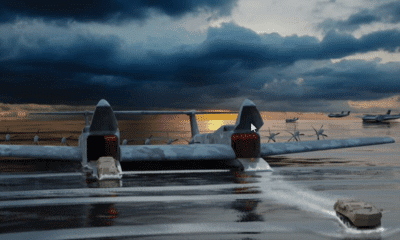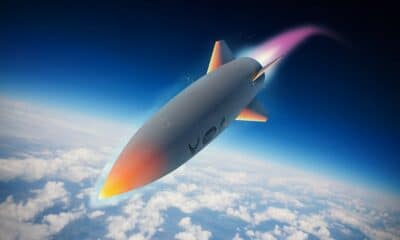Aerospace
Sikorsky And DARPA’s Autonomous Black Hawk® Flies Logistics And Rescue Missions Without Pilots On Board
Autonomous Black Hawk Flies Logistics And Rescue Missions Without Pilots On Board

Sikorsky and the Defense Advanced Research Projects Agency (DARPA) have successfully demonstrated to the U.S. Army how an unmanned Black Hawk helicopter flying autonomously can safely and reliably perform internal and external cargo resupply missions, as well as rescue operations.
The flights, which were conducted on Oct. 12, 14, and 18, as part of the U.S. Army’s Project Convergence 2022 (PC22) experiment, demonstrate how current and future piloted utility helicopters could one day fly complex missions in a low-crew or autonomous mode. In particular, in low visibility or contested environments, this would give Army commanders and aviators greater flexibility in how and when to use aircraft and pilots.
In an effort to significantly increase the efficiency and safety of rotary and fixed-wing aircraft, Sikorsky and DARPA are collaborating to develop autonomy technology. Aircrew Labor In-cockpit Automation System, a DARPA project, is built around Sikorsky’s autonomy system, also known as MATRIX™ technology.
The Sikorsky and DARPA team demonstrated during PC22 Technology Gateway how the optionally piloted Black Hawk helicopter with no humans on board can resupply troops with an external load, reroute mid-flight to evacuate a casualty, and deliver a large quantity of blood product unharmed by flying low and quickly above ground level and using the terrain to mask its signature.
India acknowledges Argentina’s interest in Tejas fighter aircraft(Opens in a new browser tab)
To begin the flight demonstrations, pilots flew and landed the Black Hawk aircraft, then activated the MATRIX system to give full control to the flight computer. When the pilots exited, the helicopter autonomously completed the following mission demonstrations:
- Long-endurance Medical Resupply: The Black Hawk aircraft flew 83 miles while loaded with 400 units of real and simulated blood – totaling 500 pounds. On reaching 40 miles from its initial take-off point, the helicopter descended into a valley as low as 200 feet above ground level at 100 knots.
- Cargo Delivery and Casualty Evacuation (combined mission): The helicopter lifted off with a 2,600-pound external load attached to a 40-foot sling, and flew at 100 knots for 30 minutes toward a designated landing zone. While in flight, the helicopter was redirected, simulating a scenario in which a threat needed to be neutralized near the primary landing site.
The second batch of uninhabited Black Hawk flights this year were the PC22 demonstrations. Sikorsky and DARPA will continue to work toward the transition of this technology for commercial applications like firefighting, cargo, and urban air mobility as well as military operations like casualty evacuation, logistics and medical resupply, and aircrew support and operations.

Aerospace
Which is bigger 777x or 787 aircraft ?

The 777X is a new series of the Boeing 777 family and is designed to be larger and more efficient than its predecessor. It features two variants: the 777-8 and the 777-9, being the larger of the two.
The Boeing 777X emerges as the larger sibling within the Boeing family, representing a significant leap forward in both size and efficiency. Comprising two variants, the 777-8 and the 777-9, the latter takes the crown as the larger of the two. With its expansive fuselage and impressive wingspan, the 777X is tailored for long-range journeys and boasts a substantial passenger capacity.
On the other hand, the Boeing 787, affectionately known as the Dreamliner, occupies a niche in the market as a smaller yet formidable aircraft designed for medium to long-range flights. Its distinguishing feature lies in its composite fuselage, a technological marvel that renders it lighter and more fuel-efficient compared to conventional aluminum counterparts. The Boeing 777X is larger than the Boeing 787 aircraft.
When it comes to passenger capacity, the 777-9 reigns supreme, typically accommodating a sizeable contingent of 400-425 passengers in its standard configuration. In contrast, the 787, with its more modest dimensions, typically carries between 240-290 passengers, depending on the variant and layout.
One of the remarkable innovations introduced with the 777X is its folding wingtips, a feature designed to address the logistical challenges of accommodating such a large aircraft in conventional airport gates. These folding wingtips enable the 777X to retract its wings, allowing it to fit into gates designed for smaller aircraft while still reaping the benefits of an extended wingspan during flight, thereby enhancing fuel efficiency and operational flexibility
Aerospace
China Secures Production Certificate for Mass Production of Pilotless eVTOL Aircraft

The first passenger-carrying pilotless electric vertical takeoff and landing (eVTOL) aircraft in the world, the EH216-S, has received the Production Certificate for its eVTOL aircraft from the Civil Aviation Administration of China (CAAC).
This is a significant milestone for EHang Holdings Limited, the leading UAM technology platform company in the world. This outstanding accomplishment is another big step towards mass manufacturing for the eVTOL aircraft and the ensuing commercial operations, building on the ground-breaking acquisition of the Type Certificate and the Standard Airworthiness Certificate for the EH216-S.
The PC is a crucial certificate that the aircraft maker receives from the CAAC, the country’s aviation authority. By obtaining this certificate, EHang has demonstrated that it has set up a quality management system for mass production that satisfies the airworthiness regulation standards set forth by the CAAC, and the company has been given permission to continue producing mass quantities.
It is also a strong guarantee of the calibre of the goods made by EHang. Raw materials, supplier management, manufacturing organisation, production quality control, aircraft pre-delivery test, after-sales repair and maintenance, etc. are all included in the mass production quality management system for the EH216-S.
To ensure that every aircraft and its components that roll off the production line strictly adhere to the approved type design and safety requirements, the system sets clear guidelines and documentation for every step in the production procedure. This ensures comprehensive traceability and safety control.
Aerospace
Four Airbus A380 Superjumbos lined up to be scrapped

In a strategic move aimed at reclaiming valuable resources from the iconic Airbus A380 aircraft, VAS Aero Services and Dr. Peters Group have announced a significant collaboration.
This partnership marks a milestone in aviation logistics and aftermarket services, with four of these colossal planes slated for teardown and redistribution of used serviceable material (USM).
The venture between VAS Aero Services, renowned for its expertise in aircraft dismantlement, and Dr. Peters Group, a prominent Germany-based investment fund management firm, underscores a commitment to sustainable aviation practices. This isn’t their first foray into scrapping A380s; their successful partnership has already seen the dismantlement of these aircraft, making them pioneers in this niche.
Under the agreement, the latest consignment brings the tally to eight A380s entrusted to VAS by Dr. Peters Group. Managing Director Christian Mailly of Dr. Peters Group emphasized the trust placed in VAS, citing their unparalleled capabilities in dismantlement and aftermarket sales network. It’s a strategic move in response to the growing demand for quality USM parts, particularly with the resurgence in reliance on the A380.
Notably, the teardown process will be carried out at various locations, optimizing the positioning of harvested parts to cater to different markets. While some parts will be positioned in Europe to support operators in the region and the Middle East, others will remain in the Asia-Pacific region. This meticulous strategy ensures efficient access to spare parts, benefiting MROs and airlines across these markets.
The decision to retire these A380s comes at a time when operators are reassessing fleet strategies amidst evolving market dynamics. Despite initial plans for quick retirement due to the emergence of more fuel-efficient alternatives, factors such as a rebound in long-haul demand and delays in new widebody deliveries have prompted operators to reconsider. The A380, with its unique capacity and capabilities, presents a practical solution for short-term capacity management.

























